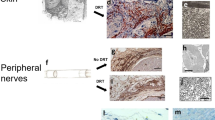Abstract.
Upon amputation of the urodele limb, the epidermal cells surrounding the amputation plane migrate to heal the wound. The resulting wound epidermis (WE) induces the regeneration process, resulting in blastema formation, cell division, and ultimately repatterning into a new limb. Despite its central role in the initiation of limb regeneration, little is known about how the WE forms. Here we discuss various models of WE formation and the experimental data in support of each. (Part of a Multi-author Review)
Similar content being viewed by others
Author information
Authors and Affiliations
Corresponding author
Rights and permissions
About this article
Cite this article
Campbell, L.J., Crews, C.M. Molecular and Cellular Basis of Regeneration and Tissue Repair. Cell. Mol. Life Sci. 65, 73–79 (2008). https://doi.org/10.1007/s00018-007-7433-z
Published:
Issue Date:
DOI: https://doi.org/10.1007/s00018-007-7433-z




